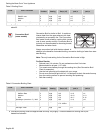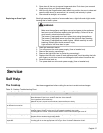
Cleaning and Maintenance
English 33
Care and Cleaning - Oven
Self Cleaning the Oven Our ovens feature a self-cleaning function that eliminates the manual labor
involved with cleaning your oven. During self-cleaning, the oven uses a very high
temperature to burn away food soil and grease.
• Do not clean parts or accessories in the self-clean oven.
• It is common to see smoke and/or an occasional flame-up during the Self-
Clean cycle, depending on the content and amount of soil remaining in the
oven. If a flame persists, turn off the oven and allow it to cool before opening
the door to wipe up the excessive food soil.
• The oven door locks at the beginning of the self-clean cycle.
• The oven light does not operate during this mode.
• During Self-Clean, the kitchen should be well ventilated to help eliminate
odors associated with Self-Clean. Odors will lessen with use.
• Four hours is the preset length of cleaning. The range can also be set to clean
for 3 or 5 hours.
• The mode automatically stops at the end of the clean hours.
• When the oven cools after cleaning, the automatic door lock will release and
the door can be opened.
• To cancel or stop while the mode is operating, press OFF.
• The door will not unlock until the oven reaches a safe temperature.
Preparing the Oven for Self Clean
WARNING
A flexible door gasket is necessary for a good seal. Do not clean, rub,
damage or move the gasket.
1. Remove all utensils and bakeware.
2. Remove oven racks. If oven racks are left in the oven during the self-clean
cycle, they will permanently lose the shiny finish and change to a dull dark fin-
ish. See Oven Cleaning Chart for proper care.
Burned-on food soil, dark streaks, and
specks
Soften by laying a damp paper towel or sponge on top of soil for about 30 min-
utes.
Use a plastic scrubber and glass ceramic cooktop cleaner or use the razor
blade scraper. Rinse and dry.
Greasy spatters
Use a soapy sponge or cloth to remove grease; rinse thoroughly and dry. Apply
glass ceramic cooktop cleaner.
Metal marks: Iridescent stain
Pans with aluminum, copper or stainless steel bases may leave marks. Treat
immediately after surface has cooled with glass ceramic cooktop cleaner. If this
does not remove the marks, try a mild abrasive (Bon Ami®, Soft Scrub® with-
out bleach) with a dampened paper towel. Rinse and reapply creme. Failure to
remove metal marks before the next heating makes removal very difficult.
Hard Water Spots - Hot cooking liquids dripped
on surface
The minerals in some water can be transferred onto the surface and cause
stains. Use undiluted white vinegar, rinse and dry. Recondition with glass
ceramic cooktop cleaner.
Surface scratches - Small scratches are to be
expected on the glass surface, but do not affect
cooking. In time, small scratches will become
smoother and much less noticeable with daily use
of the glass ceramic cooktop cleaner.
Apply Cleaning Creme before using to remove sand-like grains and grit such
as salt and seasoning.
Can be reduced by using pans with bases that are smooth, clean, and dry
before use. Use recommended glass ceramic cooktop cleaner daily on the
cooktop.
Table 10: Cooktop Care Chart
Type of Soil Possible Solution


















